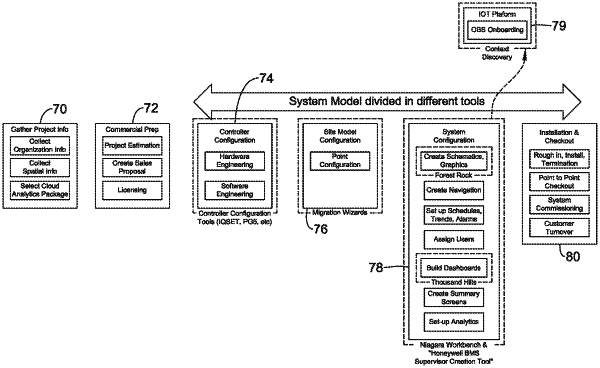| CPC G05B 15/02 (2013.01) [H04L 41/0226 (2013.01); G05B 2219/2642 (2013.01); G06Q 50/163 (2013.01); H04L 12/283 (2013.01); H04W 88/16 (2013.01)] | 20 Claims |

|
1. A Building Management System (BMS) for controlling a plurality of devices installed at a building, the BMS comprising:
a system model that is configured to be used in controlling the plurality of devices installed in the building, the system model is further configured to be developed and implemented in stages using templates with selectable elements to adhere to a single ontology of the plurality of devices installed at the building during different phases of use of the BMS including two or more of installation, engineering, commissioning, operation, and maintenance, wherein different tools utilizing the templates are used by technicians to develop and implement the system model during each of the two or more different phases, where the system model is:
(1) configured to be directly accessed and updated by the different tools used by technicians when developing and implementing the system model during the different phases including two or more of installation, engineering, commissioning, operation, and maintenance;
(2) structured to enforce standardized device names and standardized point names that are hardware agnostic for the plurality of devices installed at the building for use by the different tools when developing and implementing the system model;
(3) configured to define the single ontology of the plurality of devices installed at the building so that the different tools used by technicians when developing and implementing the system model receive updated and complete information without requiring manual re-entry by technicians of already provided information; and
(4) configured to receive hardware agnostic point information from a gateway and provide hardware agnostic control commands to the gateway for controlling the plurality of devices installed at the building;
the gateway communicatively coupled to the system model and one or more of the plurality of devices installed at the building, the gateway configured to:
receive point information from the one or more of the plurality of devices installed at the building and convert the received point information into hardware agnostic point information before sending the hardware agnostic point information to the system model;
receive hardware agnostic control commands from the system model and convert the received hardware agnostic control commands into hardware specific control commands before sending the hardware specific control commands to the appropriate devices installed at the building.
|